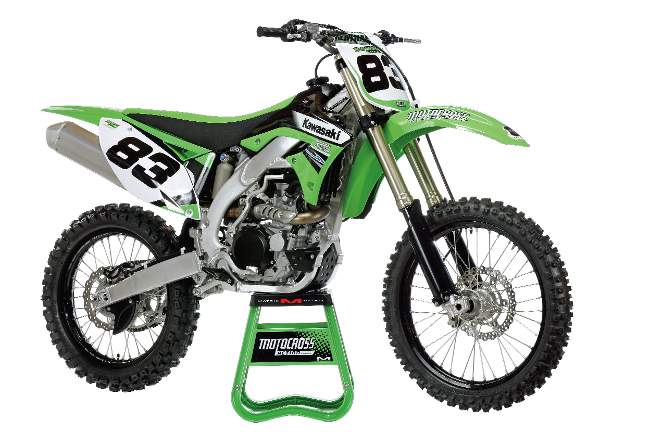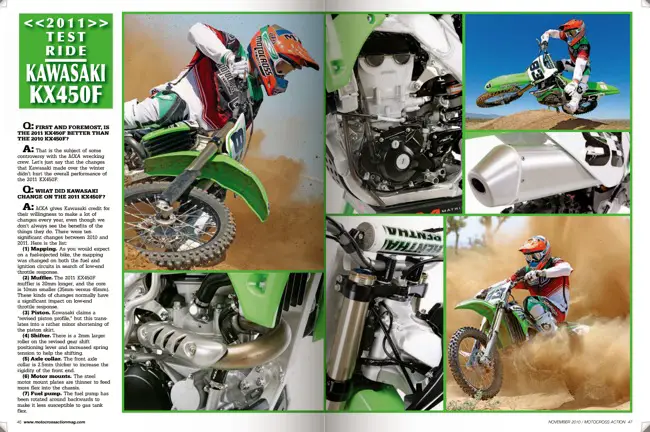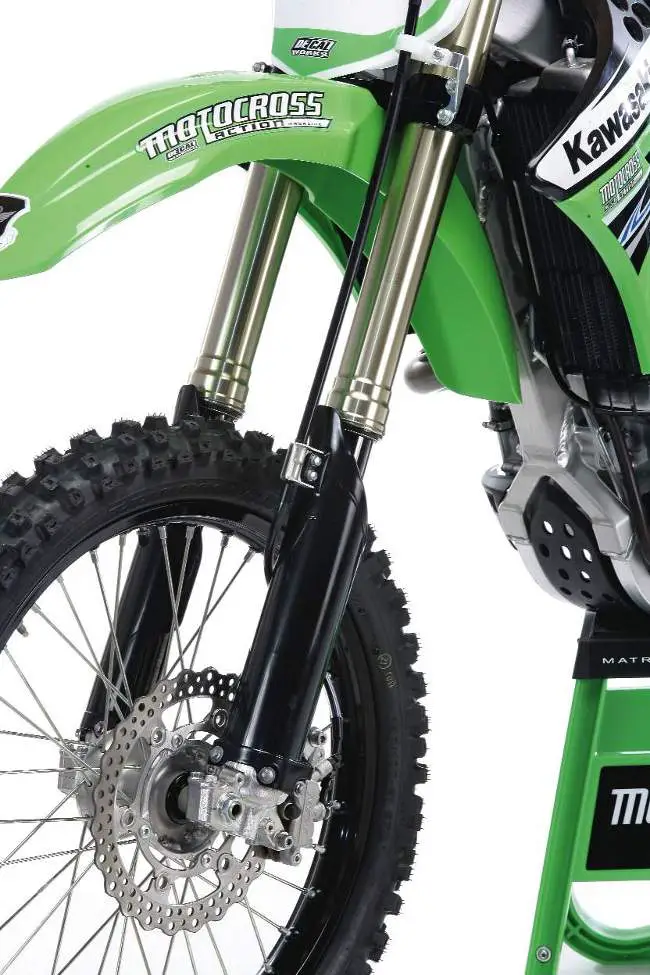TIME TRAVEL TEST: 2011 KAWASAKI KX450F MOTOCROSS TEST
Q: FIRST AND FOREMOST, IS THE 2011 KX450F BETTER THAN THE 2010 KX450F?
A: That is the subject of some controversy with the MXA wrecking crew. Let’s just say, that the changes that Kawasaki made over the winter didn’t hurt the overall performance of the 2011 KX450F. Q: WHAT DID KAWASAKI CHANGE ON THE 2011 KX450F?
Q: WHAT DID KAWASAKI CHANGE ON THE 2011 KX450F?
A: MXA gives Kawasaki credit for their willingness to make a lot of changes every year, even though we don’t always see the benefits of the things they do. There were ten significant changes between 2010 and 2011. Here is the list:
(1) Mapping. As you would expect on a fuel-injected bike, the mapping was changed on both the fuel and ignition circuits in search of low-end throttle response.
(2) Muffler.The 2011 KX450F muffler is 20mm longer, and the core is 10mm smaller (35mm versus 45mm). These kinds of changes normally have a significant impact on low-end throttle response.
(3) Piston. Kawasaki claims a “revised piston profile,” but this translates into a rather minor shortening of the piston skirt.
(4) Shifter. There is a 2mm larger roller on the revised gear shift positioning lever and increased spring tension to help the shifting.
(5) Axle collar. The front axle collar is 2.5mm thicker to increase the rigidity of the front end.
(6) Motor mounts.The steel motor mount plates are thinner to feed more flex into the chassis.
(7) Fuel pump. The fuel pump has been rotated around backwards to make it less susceptible to gas tank flex.
(8) Chain buffer. The chain guide buffer (over the swingarm) is thicker for more durability?but it isn’t thick enough.
(9) ECU interface. The connector that hooks to the map reprograming tool is now hidden behind the front number plate.
(10) Seat cover The sides of the seat cover are grippier than last year.

Power: The 2011 KX450F engine is easier to ride than the 2010 engine, but it’s still incredibly powerful.
Q: WHAT ARE THE MAJOR ENGINE CHANGES FOR 2011?
A: Haven’t you been paying attention? The engine changes are new mapping, a shorter skirt and a longer muffler. It may seem like very little, but last year Kawasaki introduced the “bridge-box bottom” piston, thicker cylinder skirt, crank with more rotational inertia, repositioned camshaft sprocket, better clutch friction plates, stronger clutch pressure plate, 40mm shorter stainless steel head pipe and bigger radiators.
Q: WHAT EFFECT DO THE THREE ENGINE CHANGES MAKE TO THE POWERBAND?
A: Before we tell you, we want everyone to understand that we loved last year’s 2010 KX450F engine. It made 1.4 more horsepower than the 2009 model and was the best low-to-mid engine in the sport. It was a pro-level engine that gave voice to the concept of “bark.”
Which leads us to the 2011 powerband. It is mellower, smoother, less abrupt, easier to use and less powerful down low. Every MXA test rider came in from his maiden voyage and said, “The 2010 engine felt like a works bike engine; the 2011 engine is toned down.”

Q: IS THE 2011 KX450F POWERBAND TONED DOWN?
A: Yes, but only off the bottom. The 2010 engine was a thing of beauty. It hit hard, pulled hard and carried farther than any other fuel-injected powerplant. (It should be noted that the KTM 450SXF is not fuel-injected.) On sheer horsepower, power placement and purity of purpose, there is nothing like last year’s 2010 KX450F power delivery. It was “works power for peons.”
The 2011 powerband isn’t as works-like. It is, dare we say it, KTM 450SXF-like. The KTM powerband builds power in a metered manner. Then, as the rpm rises, the Katoom’s power just keeps growing. The mellow low-end transforms itself into a fire-breathing beast and that makes the Keihin-equipped KTM unique in a world of abrupt-hitting and short breadth fuel-injected bikes from Honda and Yamaha.
Guess what? Kawasaki calmed down their low-end thrust to make the 2011 KX450F easier to ride. It is essentially a fuel-injected version of the KTM powerband — mellow off idle, progressively quicker in transition from low-to-mid and blazing fast from mid-to-sign-off.

I beg to differ: The major difference between a 2011 KX450F and a 2010 KX450F is that the power delivery on the 2011 model is more manageable. The rest of the bike feels very Kawasaki-ish.
Q: HOW FAST IS THE 2011 KX450F?
A: This is a tit-for-tat equation. The 2010 KX450F blasted off the mark and had unequaled thrust from 5000 rpm to 7000 rpm. The 2011 KX450F is a lot more manageable from 5 to 7 grand. Once both engines get going, one abruptly and one smoothly, there isn’t a lot of difference between them. The year-old engine is racier, but we fully understand that the brand-new powerband is better for a broader spectrum of riders. One thing we learned during a year of racing the 2010 KX450F is that not every rider wants to own a works-style powerband or its full expression of thrust. The 2010 KX450F was all-powerful and all-consuming. It didn’t need to be hopped-up because it was already hopped-up beyond pill-popping potential.
The 2011 engine is just as potent, but it is a lot more manageable. It is smoother and almost silky in its ability to accept small doses of throttle. It is infinitely more usable at low rpm than last year’s engine and doesn’t require a 100-percent commitment to forward motion.
Q: HOW DOES THE 2011 KX450F RUN ON THE DYNO?
A: The dyno curves on both the 2010 and 2011 KX450F are very similar‚, where they differ is that the 2010 bike is much stronger off idle (from 5000 rpm to 7000 rpm) and a little stronger on top (from 9000 rpm to 10,500 rpm).
So where does the 2011 bike shine? It would be easy to say that the 2011 KX450F is stronger than its 2010 brother through the meat of the powerband (7000 rpm to 10,000 rpm). And, if you looked at peak horsepower, you might believe it. The 2011 KX450F’s peak power is 54.17 horsepower at 8600 rpm. This is two-tenths of a horsepower better than the 2010 model at peak (53.90). When you look at power output at 1000 rpm increments across the midrange, the 2011 KX450F makes more horsepower than the 2010 model at 7000 rpm, less horsepower at 8000 rpm, more horsepower at 9000 rpm and less horsepower at 10,000. The peak horsepower of both bikes is tucked into the 8000 to 9000 rpm window.
What does it all mean? The 2011 is mellow off the bottom and a little stronger from low-to-mid, while the 2010 is stronger off the bottom and better on top. But, and this is a big but, the only thing you’ll notice in the saddle is the difference in thrust off idle.
Q: HOW DOES KAWASAKI’S FUEL INJECTION COMPARE TO THE CRF450, YZ450F AND RM-Z450 EFI?
A: There is no comparison. Well, there is one comparison, but it is to the Keihin FCR carb on the KTM 450SXF.
Fuel-injection system to fuel-injection system, Kawasaki has won this war hands-down. Unlike its blue, yellow and red competitors, the KX450F has all the benefits of fuel injection without the herky-jerky low-end throttle response and flat top-end. Kawasaki knows something about setting up an injector system that the other manufacturers don’t (the KX450F has a 43mm throttle body, 45-degree injector angle, 12-hole nozzle and 60-micron fuel particles). Write this down: Kawasaki has the best fuel-injected 450cc engine.
Q: IS THERE ANYTHING NOT TO LIKE ABOUT THE 2011 KX450F ENGINE?<
A: Yes. The old-school four-speed gearbox (which had a useless fifth gear tacked on back in 2007) has odd gear ratios. You are either galloping or coasting. We overlooked this gappy gearbox in 2010 because the burst of the KX450F could jump over any gap. With the 2011 model’s smoother low-to-mid transition, the gear bugaboos are back.

Grab handles: Agility isn’t the KX450F’s thing—it’s all about brute power.
Q: WHAT DID KAWASAKI DO TO THE 2011 KX450F SUSPENSION?
A: They gave it a touch-up, not a makeover, redo or total revision. They made small changes that resulted in small improvements.
Forks: If you are looking for qualitative changes to the forks, you won’t be impressed to find that the rebound damping is a little lighter. Nor will you care that Kawasaki saved money by dropping the cartridge bushings, modifying the pressure piston and swapping to a plastic spring holder seat. From a technical standpoint, the oil height is the same, the spring rate is the same, the compression damping is the same, and the performance is within one click on rebound of being the same. Kawasaki claims lighter rebound damping and revised compression for a more linear dampening rate, but a shim-for-shim analysis didn’t confirm this.
Shock: The 2011 KX450F shock is different. The low-speed compression damping is stiffer; the mid-speed damping is softer, and the high-speed damping is stiffer. This might sound a little schizophrenic, but it actually makes sense. By making the low-speed compression stiffer, Kawasaki’s suspension engineers hoped to hold the rear end higher in its stroke through small bumps. By softening the mid-speed, they planned to get a more fluid transition in small to big bump absorption. Then, by stiffening the high-speed damping, they intended to aid bottoming control. Additionally, the rebound damping is a hair slower than it was in 2010.
Q: WHAT DID KAWASAKI DO TO THE 2011 KX450F CHASSIS?
A: Nothing.
Q: HOW DOES THE 2011 KX450F HANDLE?
A: It handles the same as it did last year, which is exactly how it handled the year before and the year before that…ad nauseum.
Obviously, money is tight for the R&D department, but history proves that even when the KX450F R&D department is rolling in dough, they don’t want to make the changes the MXA test crew wants. What do we want? A steeper head angle, shorter wheel base, lower seat height, smaller overall size, better ergonomic riding position, less fork offset and a 15-pound weight loss. Until Kawasaki moves in that direction, the KX450F will maintain the same cranky characteristics that its brethren have displayed since 2006.
This is a big bike and, even worse, it feels like a big bike. It is tall, heavy and long. It doesn’t want to turn as much as it wants to stand up in the center of corners.
Q: HOW STRONG ARE THE BRAKES?
A: A bike this fast and heavy needs the best brakes it can get. Unfortunately, the Kawasaki brakes are not crisp, powerful and accurate. They stop the bike, but not like they should.

Q: WHAT IS THE SUGGESTED RETAIL PRICE?
A: The manufacturer’s suggested retail price (MSRP) is $8149.
Q: WHAT DID WE HATE?
A:The hate list:
(1) Size. It’s too big, too tall and too heavy.
(2) Shifting. We would hazard a guess that Kawasaki has changed its shift mechanism more times in the last 10 years than all the other manufacturers combined. Why? Because they can’t get it right.
(3) Gearbox. This gearbox is six years old. It wasn’t right the first time, and it hasn’t gotten better with age. As awesome as the powerband is, it could be twice as good with proper gear ratios.
(4) Rear brake pedal. If you want to run the rear brake pedal low, you have to hacksaw off some of the plunger’s threaded rod.
(5) Clutch. It feels wimpy from the get-go. Surprise! It doesn’t get any better with use. We put in stiffer clutch springs on day one (which is how long the stock clutch lasted).
(6) Weight. We are into nostalgia as much as the next guy, but not when it comes to bikes weighing as much as they did 25 years ago.
(7) Graphics. If you find a set on the track, they are probably ours. The bottom half of the radiator shroud decal kit fell off before the little nubs on the knobbies wore off.
(8) Tires. When you have a bike that doesn’t want to turn, you don’t put a 90 front tire and 120 rear on it.
(9) Chain guide. What chain guide? It wears out fast. Watch both the slider on top of the swingarm and the rubber block in the lower chain guide?watch them disappear before your eyes.
(10) Throttle grip. If you want to install aftermarket grips on the KX450F throttle tube, lots of luck. It is vulcanized onto the throttle tube.
(11) Cotter pin. Kawasaki’s lawyers must insist that their motocross bikes come with cotter pins in the axle nut. It drives us crazy. We replaced the Kawasaki axle nut with a self-locking Honda axle nut.

Q: WHAT DID WE LIKE?
A: The like list:
(1) Powerband. We love this powerband. Yes, there are MXA test riders who preferred the more pro-like 2010 powerband, but the 2011 power delivery still twangs the strings of our heart.
(2) Sound. Thanks to the longer muffler (with its smaller outlet), the 2011 KX450F passed the AMA’s 94 dB sound test with flying colors. It made a very soothing 90.5 dB on the AMA test (6 decibels less than last year). Unfortunately, it failed the FIM’s 115 dB two-meter-max test with an ear piercing 119 dB.
(3) Starting. Kick it once to activate the electric gizmos. Kick it twice to start it. Never fails.
Q: WHAT DO WE REALLY THINK?
A: This is a kinder and gentler KX450F, which means that it is still more powerful than its yellow, red and blue competition. It’s a bike that all about its engine and less about the other stuff.

Twice: Unlike the KX250F, the KX450F has two fork springs.
MXA’S 2011 KAWASAKI KX450F SUSPENSION SET-UP
Q: WHAT WAS OUR BEST FORK SETTING?
A: For hardcore racing, these are MXA‘s recommended 2011 Kawasaki KX450F fork settings:
Spring rate:< 0.47 kg/mm
Oil height:340cc
Compression: 10 clicks out
Rebound: 10 clicks out
Fork leg height: 5mm up
Notes: The chassis is very sensitive to fork height. As a rule, we ran the forks up in the clamps until we got oversteer, then slid them down 2 millimeters.
Q: WHAT WAS OUR BEST SHOCK SETTING?
A: Last year’s KX450F had an all-new bell crank and link arms mated to a stiffer 5.5 kg/mm shock spring. This year, the linkage and spring remain the same. For hardcore racing, these are MXA‘s recommended 2011 KX450F shock settings (for the stock setup).
Spring rate: 5.5 kg/mm
Race sag: 100mm
Hi-compression: 1 turn out
Lo-compression: 8 clicks out
Rebound: 8 clicks out
Notes: We run a Pro Circuit shock linkage on the 2011 KX450F to: (1) Lower the seat height by 10mm. (2) Rotate the bell crank deeper into its curve before the shock starts to move. (3) Make the compression damping a little firmer initially.








Comments are closed.